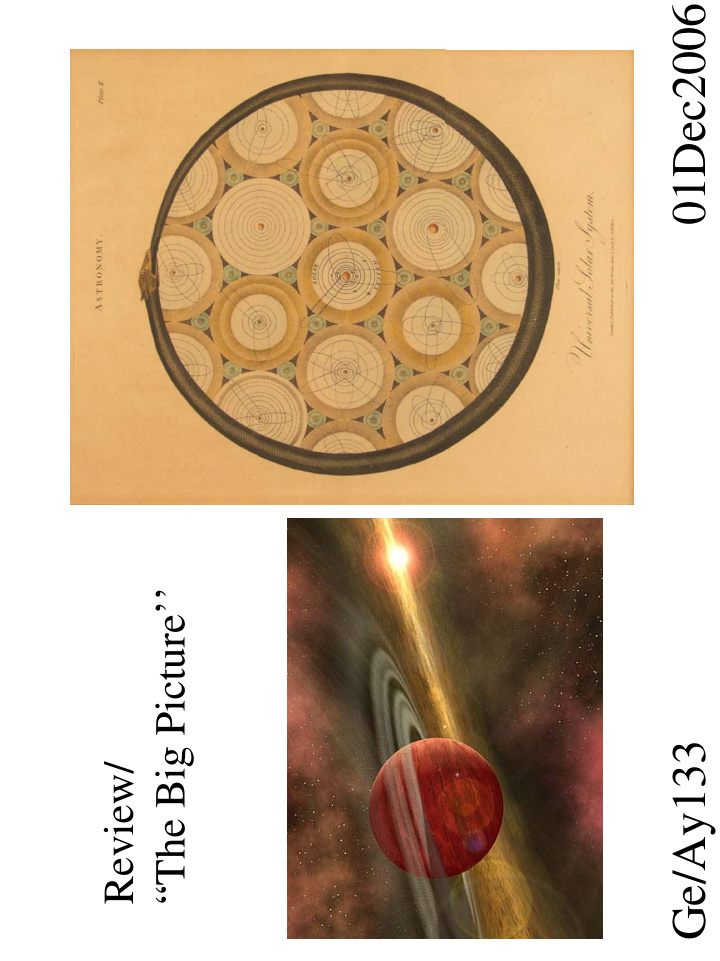



01Dec2006 “The Big Picture’’ Ge/Ay133 Review/
0.05-5 AU region. Jovian planets througout the And…
No strong preference for orbital distances… …except for a “pile up” of hot Jupiters at P~3 days.
Why do we care about gas & ice in disks? Disk-star- and Theory protoplanet interactions lead to migration while the gas is present . Core- accretion & ice? 1 AU at 140 pc subtends 0."007. Jupiter (5 AU): V doppler = 13 m/s Simulation G. Bryden (JPL) V orbit = 13 km/s Observation?
Characterizing large disk samples? SED Models: HH 30 G.J. van Zadelhoff 2002 Chiang & Goldreich 1997 IR disk surface within several 0.1 – several tens of AU (sub)mm disk surface at large radii, disk interior.
Statistically, how long do gas/dust rich disks “survive”? Basic result: Disks dissipate within a few Myr, but with a large disp. for any SINGLE system. When they go, however, the dissipation is FAST in comparison w/ disk “lifetime.”
Putting it all together: A comparison of various disk dispersal mechanisms The stellar encounter (SE) and external photo- evaporation time scales are calculated for the core of the Orion proto- stellar cluster. Hollenbach et al. (2000, PP IV)
Did the Sun form as part of a rich cluster?
One important set of clues: Short-lived nuclides in meteorites Murchison CAIs terrestrial terrestrial Thin section (chondrules)
How do we tie astronomy & meteorite timescales together?
How do disks evolve, REALLY?
This? Or this? Turbulent disks & stochastic migration.
Look at time to open a gap as compared to the viscous response time scale of the disk gas. Find: Planet mass needed to open gap:
CO Good Dynamical, Temp. Tracer Dent et al. 2005, JCMT T MB (K) v LSR (km/s) The CO line shape is Sensitive to: R disk , M star, Inc. These can be measured M. Simon et al. w/resolved images: 2001, PdBI
Disk chemistry? Depending on dust opacity, cores may spend a long time in the “plateau” phase before runaway gas accretion. Form cores closely spaced in higher density region. Need spatially resolved measurements of disk gas & its composition.
Enter ALMA: Dust simulation (L.G. Mundy), realistic phase errors, but no CLEAN/MEM. Superb site & large array exceptional performance (50 12m telescopes, by 2012). Llano de Chajnantor; 5000 m, good for astronomy, tough for humans!
When rings are seen around >10 Myr old stars… the dust must be made in place. • CSO/HST have reached similar conclusions about structure of the disk around Fomalhaut and how it is generated. Is there a planet required to maintain it? Kalas, Graham, & Clampin – Marsh et al. – ApJ, Feb. 2005 HST, Nature, June 2005
The future: discovery space for indirect methods… Radial velocity Astrometry
HD 149026 Transiting systems rare but incredibly informative…
… and photometry from space can be extremely good! Brown, T.M. et al. 2001, ApJ, 552, 699 HD 209458 - HST The KEPLER mission is dedicated to photometry and can search for earth mass planets in the so- www.kepler.arc.nasa.gov called habitable zone via transits.
IDPs can be analyzed in the lab! Comet dust assembled from sub- micron sized components.
provenance! Samples of known
1999 KR 16 First (non-Pluto) trans-Neptunian object found in 1992 (Jewitt & Luu), now many many hundreds. They are found through their motion on the sky, gives R, i fairly quickly.
Plutinos 3:2 2:1 g n i s s o r c e n u t p e N scattered KBOs classical KBOs
What can meteorites tell us about the early S.S.?
These irons and pallasites likely originate in the cores or core-mantle boundaries of differentiated bodies.
Equilibrium Gas Abundances in Silicate Magmas SiO 2 + 2Fe 3 O 4 → 3Fe 2 SiO 4 + 0 2 SiO 2 + 2Fe + O 2 → Fe 2 SiO 4 The atmosphere is also strongly affected by core formation, and its timing.
The future: discovery space for indirect methods… Radial velocity Astrometry
Finding other Earths? The Space Interferometry Mission (SIM)
If we locate other Earths, how might we then characterize them in detail? TPF-I TPF-C
Nulling: Use the fringes to suppress the central star. First tests w/ Keck in 2006. TPF?...
What can remote sensing of atmospheres tell us?
What would be possible with TPF as presently envisioned? About R ≈ 100 even in the very best set of circumstances. What might you want?
Coupled evolution of the biosphere and atmosphere:
R ≈ 1000 needed to distinguish abiotic and prebiotic earth
Recommend
More recommend